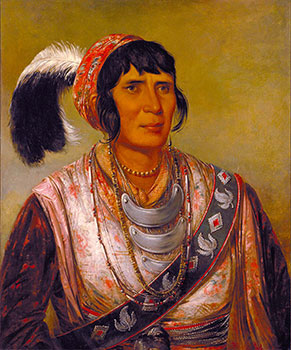|
November and December 1837
In 1830, President Andrew Jackson passed the Indian Removal Act. This act of legislation changed the course of history for many Native American tribes. It sparked the Trail of Tears, the forced relocation of thousands of tribe members, and instigated violence and war in many locations around the United States. One such location is Florida.
In accordance with the new act, the Seminole Tribe was told that they must leave Florida and relocate to Indian Territory (present-day Oklahoma). Some chiefs agreed to these terms, hoping to avoid war, and submitted to removal, but others refused. Standing up for their right to stay on their homeland, the Seminoles ignited a resistance that culminated in a seven-year war lasting from 1835-1842. The Second Seminole War, as it came to be known, was one of the deadliest and costliest American Indian Wars ever fought on US soil. During this war, a group of Seminoles was captured and brought to St. Augustine as prisoners. The way in which they were captured caused an outcry amongst the rest of the Seminoles and many white Americans as well. Seminole leaders, warriors, and their families gathered at Fort Peyton, seven miles south of St. Augustine, for an intended negotiation. The group had been summoned to that location by General Jesup with the pretense of a peaceful parley. The group approached the fort, under a white flag of truce, and as they proceeded towards the fort, they were surrounded by soldiers and taken as prisoners. Over 230 prisoners were eventually brought to St. Augustine and imprisoned inside Fort Marion, as the Castillo was known at the time. During their confinement, they were kept in the rooms on the west side and southwest corner of the fort. They were constantly kept under guard. They were permitted access to the courtyard for daily exercise, but they were not permitted beyond the gates of the sally port. Illness would prove to be a constant concern and pervasive problem during their two-month confinement in November and December of 1837. Included in the group of prisoners was the famous Seminole war leader, Osceola. He was not a chief, which is a common misconception, but he was very influential during the early phase of the war. He was known to be an inspiring speaker who generated enthusiasm and support for the war effort and rallied his troops during the toughest of battles. Unfortunately, Osceola was very ill during his imprisonment, possibly suffering from quinsy or malaria. While imprisoned, he was treated by a local physician named Dr. Weedon. When the group was eventually moved to Fort Moultrie in Charleston, South Carolina, Dr. Weedon traveled with the prisoners and treated Osceola until his death. Osceola is buried on the fort’s property today.  Another well-known prisoner at Fort Marion was Coacoochee, or Wild Cat. Wild Cat was also an influential leader during the war. He, however, was not destined to remain a prisoner in St. Augustine for very long. On the night of November 29, 1837, he led a daring escape from the fort. On that night, 20 prisoners somehow made their escape to freedom, but the details of that escape are highly debated today. According to US Army records, the prisoners escaped by climbing out of a window in a room in the southwest corner of the fort. Wild Cat, who later told his version of the story to an author and reporter, also claimed that he climbed out of a window of the fort, but he claimed that only he and one other man escaped. Some contemporary historians debate that such an escape would not be feasible due to the size of the aforementioned windows in the walls. Other versions and theories have been put forward, but no one truly knows what happened that night. The details of the escape may be less important than the fact that it happened at all. After Wild Cat escaped from Fort Marion, he continued to fight with Seminole forces and led many victories in battle. Some historians argue that his escape helped to rally weary fighters to continue their efforts and that his leadership changed the course of the war. If Wild Cat had not escaped, the outcome of the war and the future of the tribe could have been very different. Even today, most members of the Seminole Tribe of Florida trace their heritage back to those 20 prisoners who escaped. The war between the Seminole Tribe and the US Army concluded in 1842, but there was never an official treaty ending the conflict. In 1842, many of the surviving Seminoles in Florida fled south, seeking refuge in the Everglades, and the Army gave up their effort to remove them from the territory. To this day, the Seminoles still call themselves the Unconquered People. |
Last updated: September 23, 2022
